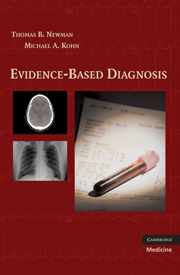Book contents
- Frontmatter
- Contents
- Preface
- Acknowledgments & Dedication
- Abbreviations/Acronyms
- 1 Introduction: understanding diagnosis and diagnostic testing
- 2 Reliability and measurement error
- 3 Dichotomous tests
- 4 Multilevel and continuous tests
- 5 Critical appraisal of studies of diagnostic tests
- 6 Screening tests
- 7 Prognostic tests and studies
- 8 Multiple tests and multivariable decision rules
- 9 Quantifying treatment effects using randomized trials
- 10 Alternatives to randomized trials for estimating treatment effects
- 11 Understanding P-values and confidence intervals
- 12 Challenges for evidence-based diagnosis
- Answers to problems
- Index
- References
10 - Alternatives to randomized trials for estimating treatment effects
Published online by Cambridge University Press: 04 August 2010
- Frontmatter
- Contents
- Preface
- Acknowledgments & Dedication
- Abbreviations/Acronyms
- 1 Introduction: understanding diagnosis and diagnostic testing
- 2 Reliability and measurement error
- 3 Dichotomous tests
- 4 Multilevel and continuous tests
- 5 Critical appraisal of studies of diagnostic tests
- 6 Screening tests
- 7 Prognostic tests and studies
- 8 Multiple tests and multivariable decision rules
- 9 Quantifying treatment effects using randomized trials
- 10 Alternatives to randomized trials for estimating treatment effects
- 11 Understanding P-values and confidence intervals
- 12 Challenges for evidence-based diagnosis
- Answers to problems
- Index
- References
Summary
Introduction
We said in Chapter 9 that randomized blinded trials are the best way of determining treatment effects because they minimize the potential for confounding, co-interventions, and bias, thus maximizing the strength of causal inference. However, sometimes observational studies can be attractive alternatives to randomized trials, because they may be more feasible, ethical, or elegant. Of course the issue of inferring causality from observational studies is a major topic in classical risk factor epidemiology. In this chapter, we focus on observational studies of treatment effects rather than risk factors, describing methods of reducing or assessing confounding that are particularly applicable to such studies.
Confounding by indication
We discussed in Chapter 9 that confounding refers to the distortion of the effect of variable A on the outcome C by a third variable B, which is both associated with A and a cause of C. We focus on treatments that are supposed to be beneficial, that is, to have an RR < 1 for a bad outcome. One type of confounding makes treatments appear better than they really are – for example, finding a beneficial treatment effect when, in truth, the treatment either has no effect or causes harm. In this situation, a confounder is associated with receiving the treatment and reduces the risk of a bad outcome (Fig. 10.1).
- Type
- Chapter
- Information
- Evidence-Based Diagnosis , pp. 206 - 219Publisher: Cambridge University PressPrint publication year: 2009



